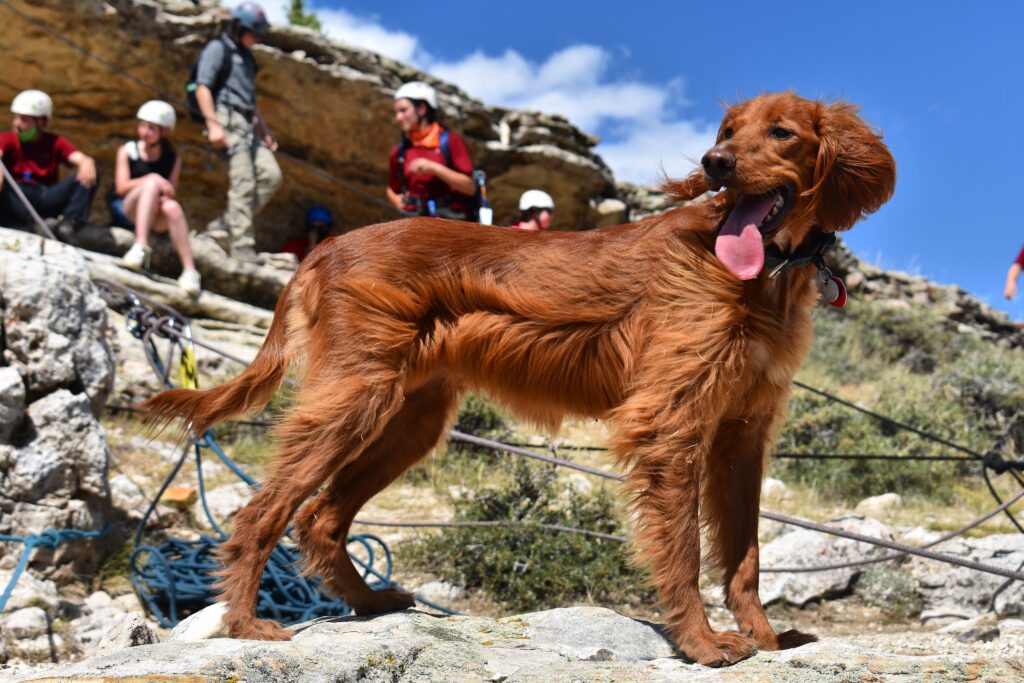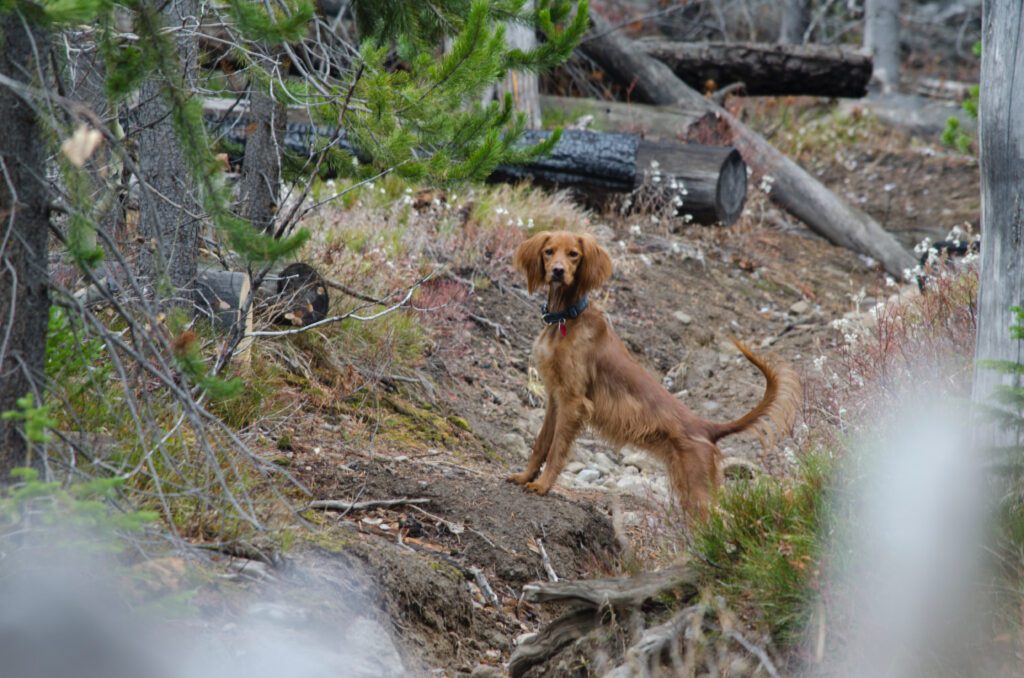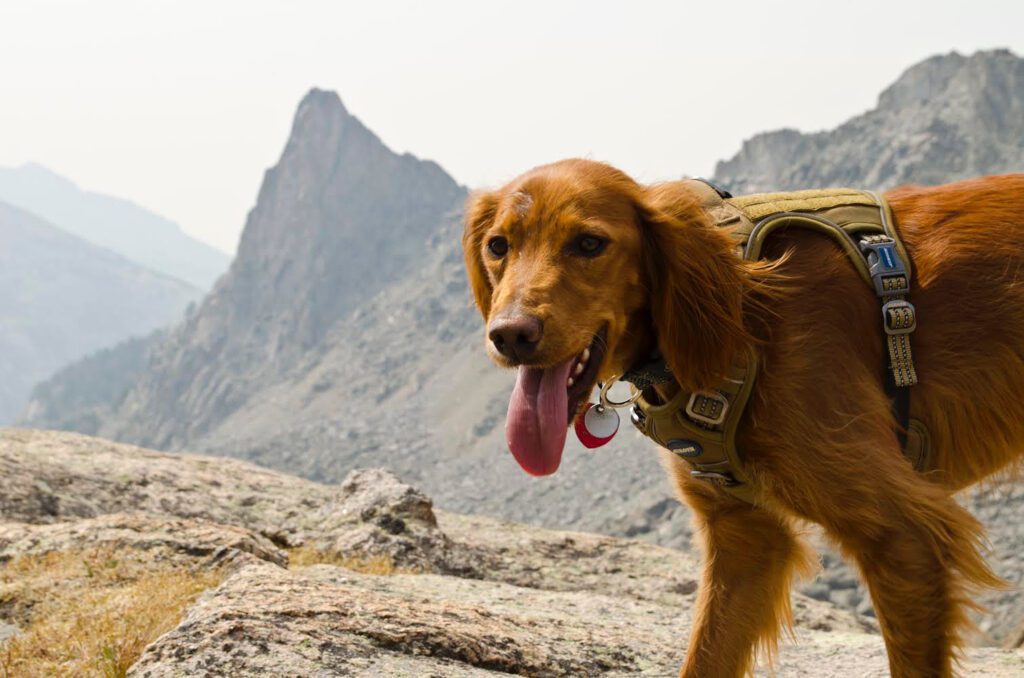On a chilly evening in the suburban sprawl of Northern Virginia, I set about my usual nighttime ritual of taking our middle-aged field-bred Red Setter, Rosie, out for her postprandial perambulation. This more lithe version of the Irish Setter popularized in the mid-twentieth century by Jim Kjelgaard’s Big Red books and Richard Nixon’s King Timahoe, is a tidy, but excitable, thirty-five pounds, the ideal size for road trips, backpacking, and an overpriced DC-suburb apartment filled with, what will soon be, three girls under the age of three. In addition to her diminutive size, Rosie is loving and gentle with the small humans in the home, and always overjoyed to meet a fellow-four-legged friend—for every dog and every person that she meets, she assumes will be her new fast friend.
Early Life Lessons
This is due partly to nature—her breed is a particularly friendly one—but also to nurture as she started her life with me as a six-week-old, several-pound, roly-poly puppy at a start-up school for boys in the distant suburbs of Boston, Mass. Along with her brother, Copper, she would toddle around the farmhouse classrooms where I taught, seeking out the messiest of the boys to lick the Peanut-Butter-n-Fluff-smeared shoes and pants or sniff the ever-interesting collection of mud tracked in from the fifty-acre farm that was the school’s campus. The school’s chickens were an interest to her too, as were the family dogs that sometimes leapt from carpool cars to rush over and meet these small red rascals which gamboled about the property as freely as the foxes or the rafters of turkey. As much as we enjoyed the farm, adventure called again to this third-born son, and soon enough, Rosie and I decamped for Jackson, Wyo., where again, she thrived as an off-leash dog.

It took some time for her to discover that elk and moose droppings were to be avoided—several nights of explosive diarrhea followed by baths in the Snake River soon convinced her that both feces and water, while endlessly intriguing, were to be avoided at all costs. On one hike, in national forest land on the backside of the Tetons, she scampered off at the trailhead, and we did not meet again until seven miles later, a quarter-mile from the summit. As it happened, she had gone off exploring, met many new friends (made known by the hikers we passed on the way down, all of whom knew her by name), and figured, like me, that the hike was still worth doing, whether alone or together. Daily walks through the woods or beside the river offered her ample opportunities to learn trail etiquette, and over time, she excelled at the process of many off-leash dogs: acknowledge passing dogs, offer a few polite sniffs, perhaps a small tussle with one of equivalent age, and then move along, while the owners exchanged pleasantries themselves: a brief comment on the weather or river hydrology perhaps, or a compliment aimed at some outdoor clothing accessory. At the very least, eye contact was made between the humans, a nod or a smile was shared, and the dogs and persons would continue on their contemplative walk, the sound of the river rushing by, squabbling geese and mergansers solving their own problems while bobbing on the current.
Sometime later, in another mountain town, this one a few hours to the east, the gateway to the majestic Wind River Range, known only to most through Taylor Sheridan’s film, Wind River, despite their arguably more impressive beauty to Jackson Hole’s Tetons (of course, to truly appreciate them, one has to leave sight of the car, which though tempting, is often a bridge too far). There, we lived in town, and she still walked off-leash, whether we were on Main Street—walking past mule deer more bold than the squirrels of Notre Dame and rabbits as populous as Watership Down—or walking the gravel road of the town cemetery at sunset, the western sky painting with all the colors that it does as the sun sets smokily over the mountains. She came to work with me, sitting below my desk, greeted visitors at the door, and found her way onto my workplace’s social media pages, garnering so much love that she no doubt had a role in the near-tripling of followers while she was in residence. On walks, people would greet her by name whom I had never seen before. She was popular in town. She was, and is, by all accounts, a good dog. Which brings me back to the present, where bound by leash laws and sensitive neighbors, she lives most of her outdoor life tethered to a six-foot lead.
Ghosted by Potential
Anyhow, as we were walking down the interior stairwell of our postwar condominium building, we came across a downstairs neighbor who was walking up the stairs with her giant, white Great Pyrenees (coincidentally, my first dog was also a Pyr and I am partial to the large breed—a great family dog and a tireless companion for adventures-galore, if ill-suited for apartment-life), who has a loud bark and a lot of muscle. Upon seeing us, the dog’s owner panicked and quickly began pulling the dog away. I said, “Let’s just let the two dogs sniff and walk past each other.” She replied, “No, no, I’ll go outside.” And she pulled the barking dog down a flight of stairs, as the Pyr lunged over and over again toward Rosie, the Pyr’s owner talked to her dog in baby-talk, while the two of us walked slowly and stoically behind the pulling owner and the lunging, barking dog.

That was many months ago, and the Pyr and Rosie have yet to have a good sniff. They bark at each other through the floor, but somehow our neighbor has managed to evade us, whether by happenstance, or perhaps planned exits, I cannot say.
This sort of dog-walking behavior is not necessarily surprising: anyone who has walked a dog since Covid first struck can empathize with the odd habit of people walking to the other side of the street rather than passing by on the same stretch of sidewalk. Neither is it rare to see owners tugging away their dogs as the two beasts strain to interact before deciding that the other dog must be an enemy and then commencing a cacophonous howling and gnashing of teeth. One wonders if it is so much of a stretch to consider that perhaps we are teaching our children similar things when we instruct them not to interact with other children, or badmouth our children’s classmates and teachers, or talk in overly-pessimistic tones at the dinner table, or work against our children’s teachers rather than with them.
Coddling for Safety or Confronting Danger?
Rosie will never be able to communicate to her Pyreneen compatriot that safety should not be the goal; that sheltering in place is not the answer to a dangerous world; that a culture of comfort and safety-seeking leads to a culture devoid of healthy communication and commitment, two necessities which are not couched in safety, but rooted in an acceptance of the unknown, a dalliance with danger. A culture that seeks to coddle its young inherently fails to allow the young to prosper. Certainly, protecting rather than teaching may be easier in the short-term but makes life much more miserable down the road as the coddled child becomes a monster of desire with an appetite only limited by pecuniary considerations.
And yet, what better place to teach conflict-resolution than in the family home or in a trusted classroom? Certainly it would be better than informing our sons or daughters that “we don’t talk with Tom, Rich, or Mary” or ignoring another’s request for a tête-à-tête because our pride may be tarnished. Of course, in the former situation, we can encourage our children in one positive direction or another, and in the latter, we lay down our arms before entering the room. But like any dog, the people who pass through our lives will fall into a plethora of categories, from passersby to acquaintances, to the varied strata that define our friendships, and we have to learn how to interact with people in order to get to know them and make sound judgements.

Take a homeroom or section classmate, a person whom a child will, at the very least, spend a year together in the classroom, a bond which necessitates that collegiality exist. Simply ignoring is by no means a mode of communication that can be embraced. Nonetheless, beginning with a strained warning bark merely serves to switch from safety-mode to shooting-mode, eliminating the space-between: that exceptionally interesting no-man’s land filled with all the smells and potential to satisfy the heart of any adventurer. Further, in desiring to always be “safe” and “protected,” we set ourselves up to be trigger-happy, sensitive creatures incapable of relaxation and trust, not to mention the confidence necessary for achieving these two necessary attributes of a happy life.
Such goings-on, in many ways, reflect the political climate that we find ourselves at the dawn of another election: a nation unable to come to amicable agreements because we have been taught, intentionally or not, as we teach our dogs, that it is a better bet to pull away and bark loudly, and that polite conflict resolution is to be avoided as much as elk droppings and rushing water. But perhaps we would be better served following Rosie’s example: at the very least, take a sniff and we find that the other is not so different than ourselves—a person with an intellect and a will, a soul striving to find their place. And if we don’t like the smell, that’s okay too, just keep walking.
Call the Cops or Meet Your Neighbor?
Another Rosie-incident to close the loop: this one several years ago when Rosie and I found ourselves in the midst of a Nextdoor controversy, a video of us posted online, and the local police put on our trail.
It was the middle of 2020, on a pitstop in Virginia before returning west, when from the other room, I heard my then-high school sister exclaim, “Is that Rosie?!” A video had been posted, taken from a neighbor’s Ring camera, of Rosie walking a tight six feet in front of me, both of us walking briskly past the house on a sunny afternoon. Along with the video was a lengthy screed detailing the danger we had brought to the community, a request for information regarding our whereabouts, and a note that the local police had been summoned and were actively in search of the hirsute criminals. At first, I was flummoxed—surely that could not be us, surely the police were not in pursuit of two lean redheads whose only crime was a little leg stretch? But the pair in the video was undoubtedly Rosie and me. I recognized the house and there was little more to be done than to go and visit the man who had posted the video.
Upon first knocking on the door, it slowly creaked open to reveal a woman in her late-thirties peering around several inches of deadbolt. “Who are you and what do you want?” she demanded. This was, you must recall, the peak of masking and distancing—an unannounced, maskless intruder at the door was a danger beyond measure—and I asked to speak with Elias. “Who are you?” she asked. “Elias,” I said. She seemed nonplussed by the exciting fact that the two of us shared a name more interesting than “John,” but she said her husband was busy and I told her I would be back in an hour, and so I was. This time, my fellow Elias answered the door and ushered me out to his back patio.

It turned out that he had recently acquired a mature German Shepherd that was untrained (he detailed the necessity of walking his animal with two leashes) and that he was wary of living in such a dangerous neighborhood (one filled with stately million-dollar homes albeit a stone’s throw from a busy bike path) and that he was worried that my dog might attack his (slender, demure Rosie giving the Shepherd seventy-five pounds). Yet he divulged that he too was a graduate of UVa, and our conversation turned to time spent wandering through the university’s crown jewel, the Academical Village, and whether we had shared any professors, then natural law and whether it can ever be acceptable to break civil law, and then he smiled, he laughed, he relaxed, he opened up, and he admitted that he would have preferred to study philosophy, but his parents had insisted he pursue a career in business. He offered to remove the video of us from online, said that he would call the police and cancel his complaint, and then he asked if I would come again, and perhaps next time we could indulge in a cigar and some Bourbon?
As our conversation neared its end, he asked when I could return to talk again, but I mentioned that I was returning to Wyoming in a few days, that Horace Greeley’s “Go West, young man!” still echoed in the chambers of my heart and he sighed deeply, bemoaned the onset of middle age, and expressed a wish to move to South Dakota—it’s much safer there, he said.

